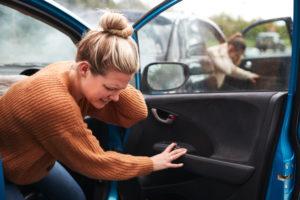

Car crashes, even at low speeds, involve incredible force. This force often causes serious, debilitating injuries. A lower back injury called spinal stenosis is one of the most common that affects the spinal canal. Symptoms are often severe, and can cause disability. Medical care is necessary for relief of spinal stenosis from a car accident.
What is spinal stenosis?
Spinal stenosis is a narrowing of the spinal canal, where the spinal cord lies. This narrowing presses on the spinal cord and spinal nerve roots and can cause the following symptoms:
- Back pain
- Weakness in the lower body
- Pain, burning, numbness, and tingling in the legs or buttocks
- Foot drop while walking
- Increase in pain while standing or walking
The violent impact from a car accident can easily damage structures in the lower back. Accidents can cause spinal stenosis on their own or exacerbate a congenital condition where the spinal canal is already narrow.
For a free legal consultation, call (614) 538-1116
How does a doctor diagnose spinal stenosis?
Spinal stenosis can be difficult to diagnose. Your symptoms may not be obvious immediately following a car accident, but it is important to get a diagnosis as soon as possible.
Most doctors will start by pressing on the areas around the spine to check for pain as well as taking X-rays of your lower back. X-rays do not allow the doctors to see the soft tissues around or inside the spinal canal, but will show damage to the vertebrae.
To confirm the diagnosis, doctors typically use magnetic resonance imaging (MRI) to look at the spinal cord and soft tissues around it. In some cases, other tests such as computed tomography scans and myelograms are also necessary to get a good view of the damage.
How can I treat spinal stenosis?
The symptoms of spinal stenosis can limit victims, and even lead to temporary or permanent disability. Many people must undergo ongoing treatment, and many miss weeks, if not months, of work. The costs of medical care add up quickly; this can be even more distressing when you are out of work.
In most cases, nonsurgical treatment will relieve your spinal stenosis symptoms and help you return to normal activities. These treatments do not widen the spinal canal, but they can help take the pressure off the compressed nerves. These treatments may include:
- Physical therapy
- Massage
- Prescription non-steroidal anti-inflammatory drugs (NSAIDs)
- Steroids
If your injury affects your mobility or majorly compromises your quality of life, your doctor may recommend surgery. Surgery for spinal stenosis sometimes requires a stay in a rehabilitation facility for a few weeks until the patient regains mobility and range of motion.
In most cases, those who undergo surgery can return to normal activities in eight to 12 weeks; many patients are able to go back to work in a few weeks. In addition to mounting medical costs and intense pain and suffering, lost wages often make this an expensive recovery. Luckily, many victims are able to recover the financial damages they suffer in a car accident from the at-fault driver’s insurance company.
Click to contact our personal injury lawyers today
How can I recover the damages from my crash?
If a car accident caused or contributed to your spinal stenosis, it is important to have a knowledgeable car accident attorney on your side. Many car insurance companies like to claim spinal stenosis is a pre-existing condition, and deny paying for treatment after a crash.
At Bressman Law, we know the tactics they use to deny these claims, and know how to counter them. We fight for every penny of compensation our clients deserve. Contact us today at 614-538-1116 to learn more.
Call or text (614) 538-1116 or complete a Free Case Evaluation form








